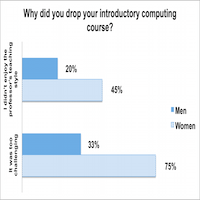Expanding the Pipeline – Building Recruiting and Inclusion for Diversity (BRAID): Emerging Research on Diversifying the CS Major
 In August 2014, Maria Klawe, President of Harvey Mudd College (HMC), and Telle Whitney, President of the Anita Borg Institute for Women and Technology (ABI), jointly established Building Recruiting and Inclusion for Diversity (BRAID). The BRAID initiative, with support from Facebook, Google, Microsoft, and Intel, involves 15 computer science departments across the U.S. that are committed to implementing changes to their introductory computer science courses, pathways into the major, departmental climate, and outreach efforts in hopes of increasing the recruitment and retention of women and underrepresented minority (URM) students in the computer science major. See http://anitaborg.org/braid-building-recruiting-and-inclusion-for-diversity/ for more information and a list of the BRAID institutions.
In August 2014, Maria Klawe, President of Harvey Mudd College (HMC), and Telle Whitney, President of the Anita Borg Institute for Women and Technology (ABI), jointly established Building Recruiting and Inclusion for Diversity (BRAID). The BRAID initiative, with support from Facebook, Google, Microsoft, and Intel, involves 15 computer science departments across the U.S. that are committed to implementing changes to their introductory computer science courses, pathways into the major, departmental climate, and outreach efforts in hopes of increasing the recruitment and retention of women and underrepresented minority (URM) students in the computer science major. See http://anitaborg.org/braid-building-recruiting-and-inclusion-for-diversity/ for more information and a list of the BRAID institutions.
To document the results of the BRAID initiative and identify best practices, the UCLA-based BRAID research team is conducting a mixed-methods, longitudinal study of the BRAID initiative. The research effort is being led by Linda Sax of UCLA’s Graduate School of Education and Information Studies and her team of graduate student researchers. With additional funding from the National Science Foundation (NSF) and the Computing Research Association (CRA), the BRAID research team is collecting data from students, faculty, staff, department chairs, and administrators in order to answer a variety of research questions related to the departmental change process and best practices for attracting and retaining women and URM students to the CS major. Additionally, the BRAID research team is collaborating with the CRA’s Center for Evaluating the Research Pipeline (CERP) to compare the experiences of computing students at BRAID departments with students at other CS departments across the United States. This article will outline the research design for the BRAID research project, share some preliminary results from one of our student surveys, and discuss plans for future research.
BRAID Research Design
The research team is currently collecting baseline mixed-methods data to gauge the success of the BRAID initiative in diversifying the CS major. The qualitative data collection involves interviews and focus groups. Specifically, our team is conducting interviews with department chairs as well as faculty and other key administrators about the departmental change process. We are also conducting focus groups with students to learn about their views on the culture and climate of CS and their specific CS departments. The quantitative data collection involves faculty and student surveys. The faculty survey will be administered each term during the 2015-2016 and 2016-2017 academic years to instructors teaching introductory CS courses to learn more about their pedagogical techniques and experiences in those courses. The student surveys target two populations: CS majors and minors and students enrolled in introductory CS courses. Each fall, all computing students (i.e., CS majors and minors) will receive a survey that parallels the Data Buddies Survey (DBS) administered by CERP. Data from this survey will be merged with data collected from CERP’s DBS, and comparative analyses will be conducted. Additionally, each term during the 2015-2016 and 2016-2017 academic years, students enrolled in introductory CS courses will receive pre-and post-test surveys to gather data on their backgrounds, self-ratings, perceptions of CS and computing, and experiences in the course and CS department. The following section will share some early results from the first administration of the introductory course student surveys.
Preliminary Findings
These results represent only the first term of baseline data collection on introductory computer science students. Of the 15 institutions included in our study, nine participated in the first term of data collection; more institutions are participating in subsequent waves as IRB approvals are secured. A total of 5,552 students enrolled in an introductory computer science course at the nine institutions participating in the fall 2015 administration, 1,904 of which completed our introductory course pretest survey for a response rate of 34%.
In terms of gender and racial/ethnic diversity, our sample includes 28% women and 23% URM students (including 7.5% African American/Black and 13% Chicano/Latino). The representation of women in the BRAID sample is higher than the proportion of women earning bachelor’s degrees in computer science (18% nationally and 17% across BRAID institutions), which is likely due to women’s higher survey response rates. We are further investigating the representativeness of our sample with respect to race/ethnicity.
Our sample illustrates the diverse computing backgrounds of introductory computing students. Of the students who responded to our survey, a quarter (26.5%) reported no programming experience prior to enrolling in the introductory course. At the same time, 29.4% reported having taken a programming course in high school and 19.9% reported having taught themselves how to program prior to the course. Gender differences in programming experience also exist, with 36% of women, compared to 27% of men, reporting the fall introductory class as their first experience with programming. Similarly, 33% of URM students reported no prior programming experience, compared to 25% of non-URM students.
Of the students who participated in our introductory course pretest survey, 40% completed a follow-up survey administered at the end of the term. These students represent the beginning of a longitudinal sample that we will continue to survey annually for the next four years. Of the students in our longitudinal sample of introductory students, 59.8% reported taking the course because it was a requirement and 25% enrolled because of an interest in computing. Influence of parents or teachers played a small role in why students enrolled in CS, with only 3.2% reporting that they enrolled because of encouragement from their parents and 3.6% reporting enrollment due to encouragement from teachers or other mentors. Students also noted the most common teaching methods used by their professors, with nearly two-thirds (62.3%) reporting that the professors in their introductory course frequently or always lectured. By continuing to track these students’ annual progress, we will learn more about which specific teaching practices and student experiences best-predict students’ persistence in CS.
Plans for Future Research
In addition to documenting the BRAID departments’ efforts and identifying best practices for diversifying the major, one of the most promising aspects of the BRAID research project is that it will establish a unique longitudinal database of thousands of undergraduate computer science students at institutions across the United States. Our research team was recently awarded a $2 million NSF grant to conduct annual follow-up surveys on the approximately 10,000 students who are estimated to respond to the introductory CS course surveys at the 15 BRAID institutions in either 2015-2016 or 2016-2017. Tracking the students beyond their introductory CS course will also allow us to assess changes in their self-perceptions, experiences with computing, perspectives on CS, and career plans. Further, we will track individual students’ enrollment patterns so as to provide more precise information about their longer-term participation in CS, including those students who leave the major. We believe that the lessons learned from both the baseline data collection, as well as the follow-up surveys, will prove invaluable to CS departments trying to recruit and retain more women and URM students in the CS major.
About the Authors
Linda Sax is a professor of higher education at UCLA and principal investigator of the BRAID research project. Kathleen Lehman is a Ph.D. student in higher education at UCLA and BRAID project manager. Jennifer Blaney is a Ph.D. student in higher education at UCLA and BRAID senior data manager.









